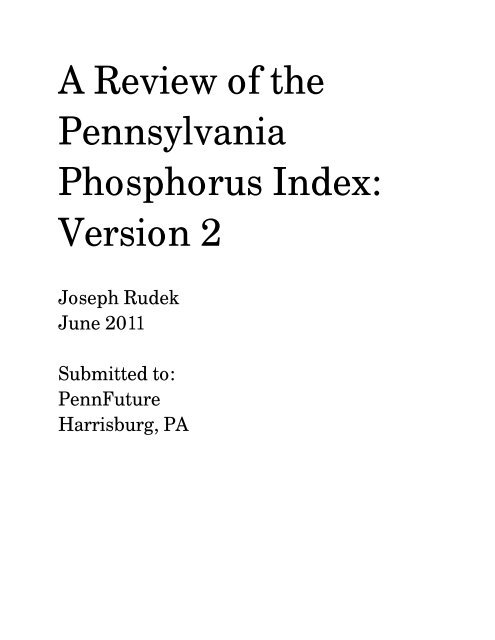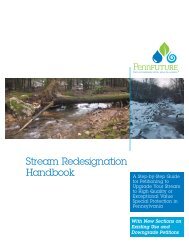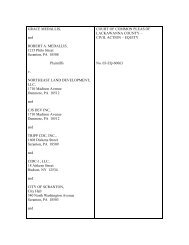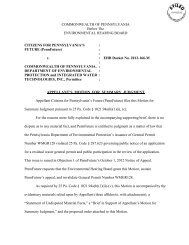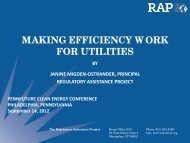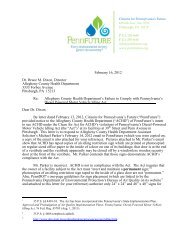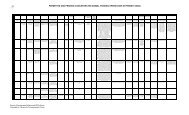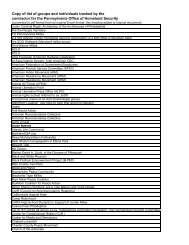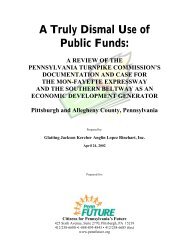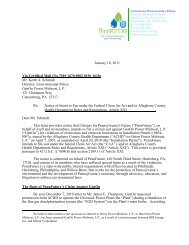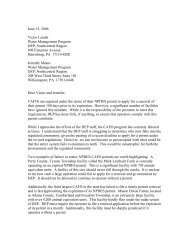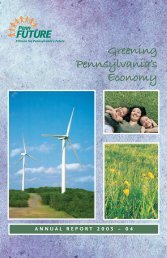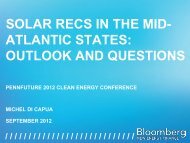A Review of the Pennsylvania Phosphorus Index ... - PennFuture
A Review of the Pennsylvania Phosphorus Index ... - PennFuture
A Review of the Pennsylvania Phosphorus Index ... - PennFuture
You also want an ePaper? Increase the reach of your titles
YUMPU automatically turns print PDFs into web optimized ePapers that Google loves.
A <strong>Review</strong> <strong>of</strong> <strong>the</strong><strong>Pennsylvania</strong><strong>Phosphorus</strong> <strong>Index</strong>:Version 2Joseph RudekJune 2011Submitted to:<strong>PennFuture</strong>Harrisburg, PA
A <strong>Review</strong> <strong>of</strong> <strong>the</strong> <strong>Pennsylvania</strong> <strong>Phosphorus</strong> <strong>Index</strong>: Version 2IntroductionFor many years <strong>the</strong> dogma in soil science was that it didn’t matter how much phosphorus (P)was put on soils because all in excess <strong>of</strong> crop needs would adhere to <strong>the</strong> soil. The only Ptransport mechanism <strong>of</strong> concern was erosion <strong>of</strong> soil. However, in <strong>the</strong> latter half <strong>of</strong> <strong>the</strong> 1990’s, itwas realized that at high soil concentrations, P could remobilize <strong>of</strong>f <strong>the</strong> soil and move in run<strong>of</strong>fwater. The run<strong>of</strong>f <strong>of</strong> P from some crop lands to waterways became a concern as levels <strong>of</strong> soil Pbecame elevated due to high levels <strong>of</strong> manure application over extended periods especially fromconcentrated animal operations which have large amounts <strong>of</strong> manure to manage. The run<strong>of</strong>f <strong>of</strong>P from agricultural lands contributes to o<strong>the</strong>r sources <strong>of</strong> P, resulting in eutrophication especiallyin lentic waters (i.e. non-running waters.) In response, <strong>the</strong> USDA added a P managementrequirement to its 590 Nutrient Management Standard, and states across <strong>the</strong> country followedup with plans to implement this standard.The <strong>Pennsylvania</strong> (PA) P-<strong>Index</strong> is divided into two parts, A and B (Beegle et al 2009.) Part A is asimple screening tool to determine whe<strong>the</strong>r nitrogen (N) based nutrient management plans aresufficient or if a farmer needs to complete Part B which calculates a P-<strong>Index</strong> to determinewhe<strong>the</strong>r nutrient management plans need to take into consideration <strong>the</strong> potential for P run<strong>of</strong>f.The Part A screening is based upon 4 criteria, an affirmative answer to any one <strong>of</strong> whichdetermines <strong>the</strong> need to complete Part B and, if appropriate, a P based nutrient managementplan. The criteria are as follows:1. Is <strong>the</strong> crop management unit in a Special Protection Watershed?2. Is <strong>the</strong>re a significant farm management change as defined by Act 38?3. Is <strong>the</strong> soil test Mehlich-3 P greater than 200 ppm?4. Is <strong>the</strong> Contributing Distance from <strong>the</strong> crop management unit to receiving waters lessthan 150 ft.?In addition, <strong>the</strong> USDA’s Natural Resources Conservation Service requires P-based evaluationsfor farms receiving technical or financial assistance for manure-related issues (Kogelman et al2006.)Part B <strong>of</strong> <strong>the</strong> P-<strong>Index</strong> is divided into 2 factors: source and transport. The source factor accountsfor P availability from <strong>the</strong> soil, fertilizer and manure. The transport factor considers erosion,run<strong>of</strong>f potential, subsurface drainage, distance to waterways (known as contributing distance),and any management practices that modify P transport (known as modified connectivity.)From <strong>the</strong> source and transport factors is derived <strong>the</strong> P-<strong>Index</strong>. The P-<strong>Index</strong> is divided into 4rating categories: Low, Medium, High and Very High. <strong>Phosphorus</strong> <strong>Index</strong> ratings <strong>of</strong> Low orMedium do not require nutrient management plans to consider potential P run<strong>of</strong>f and nutrientmanagement plans can be nitrogen based. A High P-<strong>Index</strong> rating requires that P can only beapplied at crop removal rates. A Very High P-<strong>Index</strong> rating means no P can be applied.Page 1
The P-<strong>Index</strong> source factor uses a Mehlich-3 soil test to estimate <strong>the</strong> amount <strong>of</strong> P at risk forrun<strong>of</strong>f from <strong>the</strong> soil. <strong>Phosphorus</strong> availability from fertilizer depends on <strong>the</strong> amount <strong>of</strong> fertilizerand <strong>the</strong> manner in which it is applied, whe<strong>the</strong>r applied in spring or fall and whe<strong>the</strong>r and when itis incorporated into <strong>the</strong> soil. The P available from manure, like fertilizer, is dependent on whenapplied and whe<strong>the</strong>r incorporated but also includes a P source coefficient (PSC.) The PSC canbe taken from a chart provided by <strong>the</strong> state (e.g., in <strong>the</strong> P-<strong>Index</strong> Fact Sheet), known as <strong>the</strong> Bookvalue. Alternatively, <strong>the</strong> PSC can be determined by submitting <strong>the</strong> manure sample for a waterextractableP (WEP) analysis. The WEP test option was added to Version 2 <strong>of</strong> <strong>the</strong> PA P-<strong>Index</strong>.The Part A screening test was also modified in Version 2 with <strong>the</strong> addition <strong>of</strong> two conditions; <strong>the</strong>Special Protection Waters, and <strong>the</strong> significant change in farm management. The conversion toVersion 2 was described as a natural evolution <strong>of</strong> <strong>the</strong> P-<strong>Index</strong>, recommended by a group <strong>of</strong>scientists at <strong>the</strong> USDA-ARS Pasture Systems and Watershed Management Research Unit atUniversity Park, PA and <strong>the</strong> <strong>Pennsylvania</strong> State University College <strong>of</strong> Agricultural Sciences(Beegle. pers. comm., Beegle et al 2009.) This group conducts an ongoing review <strong>of</strong> <strong>the</strong> P-<strong>Index</strong>calculation. While <strong>the</strong> use <strong>of</strong> a WEP analysis-based PSC likely lowers <strong>the</strong> P-<strong>Index</strong>, <strong>the</strong> additionalPart A conditions likely result in more farms calculating a P-<strong>Index</strong>. Dr. Beegle mentioned thatPA was considering a third version <strong>of</strong> <strong>the</strong> P-<strong>Index</strong> which might come out this year. A preview <strong>of</strong>potential recommended adjustments in <strong>the</strong> P-<strong>Index</strong> might be presaged in <strong>the</strong> SERA-17recommendations on <strong>the</strong> revisions to <strong>the</strong> 590 Nutrient Management Standard (Sharpley et al2011.)Assessments <strong>of</strong> <strong>the</strong> Affect <strong>of</strong> <strong>the</strong> <strong>Phosphorus</strong> <strong>Index</strong> on <strong>Pennsylvania</strong> AgricultureDuring <strong>the</strong> development <strong>of</strong> <strong>the</strong> PA P-<strong>Index</strong>, efforts were made to assess <strong>the</strong> impact onagriculture. In a statewide survey <strong>of</strong> over 220,000 soil samples collected in PA between 1996and 2001, Kogelmann et al (2002) found 4.8% exceeded 200 ppm P and 1.5% exceeded 300ppm P. Several counties located in <strong>the</strong> sou<strong>the</strong>astern part <strong>of</strong> <strong>the</strong> state had a higher than averagepercentage <strong>of</strong> excessively high soil P samples. Lancaster, Schuylkill and Montgomery Countieshad <strong>the</strong> highest proportion above 200 ppm P (17.6%, 16.7% and 16.1%, respectively.) Additionalhotspots were noted in Wyoming, Wayne and Lackawanna Counties in <strong>the</strong> nor<strong>the</strong>ast and ErieCounty in <strong>the</strong> northwest (Kogelmann et al 2004.) Also <strong>of</strong> note, statewide, 48% <strong>of</strong> <strong>the</strong> soilsamples had soil P test values <strong>of</strong> 50 ppm P or more. The optimum range <strong>of</strong> soil P for crops is 30– 50 ppm P. Lancaster County had 81% <strong>of</strong> soil samples exceeding crop P needs. Seventeen out<strong>of</strong> <strong>the</strong> 67 counties statewide had greater than 60% <strong>of</strong> soil samples exceeded crop P needs. Thissuggests <strong>the</strong> possible widespread over fertilization <strong>of</strong> P. Not surprisingly, a positive relationshipwas found between animal density and high soil P concentrations.Besides high soil P concentrations and animal densities, Kogelmann et al (2002) also found thata greater percentage <strong>of</strong> <strong>the</strong> agricultural lands in <strong>the</strong> north and south-central parts <strong>of</strong> <strong>the</strong> statewere in close proximity to streams (within 150 feet), elevating <strong>the</strong> risk <strong>of</strong> P loss to streams inthose areas. Modeling <strong>of</strong> run<strong>of</strong>f in hilly areas indicated that nearly all <strong>the</strong> P run<strong>of</strong>f wasgenerated from about 10% <strong>of</strong> <strong>the</strong> watershed areas, within about 98 to 197 feet <strong>of</strong> <strong>the</strong> channel(Kogelmann et al 2004). These areas, known as variable source areas (VSA’s), are likely <strong>the</strong>Page 2
asis for <strong>the</strong> 150 foot buffer condition in <strong>the</strong> screening portion <strong>of</strong> <strong>the</strong> P-<strong>Index</strong>. Kogelmann et al(2004) stated that <strong>the</strong> 150 foot buffer should encompass most run<strong>of</strong>f from VSAs. Perhaps <strong>the</strong>benefits <strong>of</strong> extending <strong>the</strong> contributing distance to 200 feet should be examined as a modification<strong>of</strong> <strong>the</strong> P-<strong>Index</strong> Part A screening test conditions.However, <strong>the</strong> above findings regarding <strong>the</strong> areas <strong>of</strong> elevated risk <strong>of</strong> P loss overestimates <strong>the</strong>acres likely to require P nutrient management. The initially calculated P-<strong>Index</strong> is not fixed andnutrient management planners can revisit <strong>the</strong> source and transport components <strong>of</strong> <strong>the</strong> P-<strong>Index</strong>and determine what changes or additional practices may be needed to reduce <strong>the</strong> risk <strong>of</strong> P loss(Kogelmann el al 2006.) Kogelmann et al (2006) examined <strong>the</strong> affect <strong>of</strong> P-<strong>Index</strong>implementation in 2 counties <strong>of</strong> <strong>the</strong> state that were likely to be highly impacted, Lancaster andSnyder Counties. Based upon screening results, 45.9% and 19% <strong>of</strong> <strong>the</strong> farms fields examined inLancaster and Snyder Counties (respectively) were required to calculate <strong>the</strong>ir P-Indices. Of<strong>the</strong>se, 31.2% and 12% <strong>of</strong> <strong>the</strong> fields in Lancaster and Snyder Counties had P-<strong>Index</strong> rankings thatrestricted P application rates based upon initial nutrient management plans. Kogelmann et al(2006) <strong>the</strong>n focused on 4 farms <strong>the</strong>y defined as highly impacted (i.e. more than one third <strong>of</strong> <strong>the</strong>farm acreage with P restrictions) to examine what types <strong>of</strong> management measures could beimplemented to ease P restrictions. Two <strong>of</strong> <strong>the</strong> four highly impacted farms appeared to require<strong>of</strong>f-farm manure transport to comply with P based nutrient management. If this ratio were toapply to all <strong>the</strong> farms that required P-<strong>Index</strong> calculation in Lancaster and Snyder Counties, <strong>the</strong>percentages prohibited from applying P would drop to about 16.5% and 6%, respectively.Overall, based upon this example, more than 60% <strong>of</strong> <strong>the</strong> farms that were required to calculate aP-<strong>Index</strong> would have been able to adjust management practices or add BMPs to lessen or removeP restrictions. However, this percentage is still likely to overestimate <strong>the</strong> farms impacted as <strong>the</strong>four farms examined were selected as worst case scenarios in counties with a higher thanaverage percentage <strong>of</strong> P problems. In addition, this example was based upon P-<strong>Index</strong>calculations using PSC Book values. If WEP-based PSC values were used, it is likely that <strong>the</strong>percentage <strong>of</strong> farms with P restrictions would be even lower still.<strong>Phosphorus</strong> Source Coefficient: Lab AnalysisThere have been numerous publications regarding analytical tests to determine <strong>the</strong> availability<strong>of</strong> manure P and its contribution to P run<strong>of</strong>f (Kleinman et al 2007; Kleinman et al 2005; Elliott,H.A. 2006; Sharpley et al 2004; Studnicka et al 2011). It stands to reason that a specific test <strong>of</strong> amanure sample would be a better determinant <strong>of</strong> its available P relative to a generalized factor.The question <strong>the</strong>n becomes how good are <strong>the</strong> analytical tests at accurately determining manureP availability? The PA P-<strong>Index</strong> uses a WEP analytical protocol described in Kleinman et al(2007.) This test essentially dissolves water soluble P out <strong>of</strong> manure samples by swirlingmeasured quantities <strong>of</strong> manure in certain volumes <strong>of</strong> water for set periods <strong>of</strong> time. The Pconcentration in <strong>the</strong> water extract is <strong>the</strong>n analyzed to yield <strong>the</strong> water extractable P (or WEP.)Studnicka et al (2011) reviewed <strong>the</strong> Kleinmann et al (2007) extraction protocol and determinedthat pre-analysis manure handling could affect WEP results but reported that those effects wereminimized and extractions better predicted spring P run<strong>of</strong>f concentrations when <strong>the</strong> manure towater extraction ratio was 1:1000 (i.e. 0.25 g <strong>of</strong> manure in 250 ml <strong>of</strong> water). These contrast withPage 3
1:100 extraction ratio (i.e. 2.5 g <strong>of</strong> manure in 250 ml <strong>of</strong> water or an equivalent ratio) which is <strong>the</strong>current standard procedure approved for use in calculating <strong>the</strong> PA P-<strong>Index</strong> (based uponKleinman et al. 2007). Studnicka et al (2011) found <strong>the</strong> 1:1000 water extraction ratio producedWEP estimates significantly higher than found with <strong>the</strong> 1:100 extraction ratio. Additionally,Studnicka et al (2007) found that WEP analysis <strong>of</strong> available manure P applied in <strong>the</strong> fall werenot well correlated with P run<strong>of</strong>f rates but were better predicted by <strong>the</strong> rate <strong>of</strong> available manureP applied. Fur<strong>the</strong>r, <strong>the</strong>y found that <strong>the</strong> run<strong>of</strong>f-to-rainfall ratio was <strong>the</strong> best predictor <strong>of</strong> run<strong>of</strong>f Pconcentrations across all seasons. In springtime, more rainfall infiltrates <strong>the</strong> soil relative to <strong>the</strong>fall and hence could help to explain why fall run<strong>of</strong>f P rates were higher than those during springapplication. However, as <strong>the</strong> run<strong>of</strong>f-to-rainfall ratios would not be known during <strong>the</strong> time <strong>of</strong>manure application, this relationship is not useable to determine allowable manure Papplication rates but ra<strong>the</strong>r would be valuable for modeling P run<strong>of</strong>f after <strong>the</strong> fact.Studnicka et al (2011) used a relatively small sample (0.25 g) relative to Kleinman et al (2007:0.5 – 100 g sample sizes evaluated). While Kleinmann et al (2007) found no relationshipbetween <strong>the</strong> weight <strong>of</strong> <strong>the</strong> sample and <strong>the</strong> relationship to dissolved P run<strong>of</strong>f, small sample sizescould be a problem with heterogeneous samples such as poultry litter (because <strong>of</strong> wood chips.)<strong>Phosphorus</strong> Source Coefficient: Influence on Allowable Manure <strong>Phosphorus</strong>To determine <strong>the</strong> influence <strong>of</strong> <strong>the</strong> PSC value on allowable manure P application rates, anexample from <strong>the</strong> <strong>Pennsylvania</strong> <strong>Phosphorus</strong> <strong>Index</strong>: Version 2 Users Guide (Beegle et al 2009)was modified and <strong>the</strong> maximum allowable manure application rates were calculated at 4different PSC values (Figure 1). <strong>Phosphorus</strong> solubility coefficients used in <strong>the</strong> calculation rangedfrom 0.8, which is <strong>the</strong> book value for dairy manure, to 0.2, which resulted in manure applicationbased upon crop nitrogen needs (i.e. no P application limits.) The specific conditions in <strong>the</strong>modified example P-<strong>Index</strong> calculations are provided in Table 1. As <strong>the</strong> Mehlich-3 soil test Plevels were above 200 ppm (201 ppm in this example), <strong>the</strong> need to calculate a P-<strong>Index</strong> wastriggered 1 . Under <strong>the</strong> example conditions, <strong>the</strong> P-<strong>Index</strong> calculation for manure application basedupon crop nitrogen needs resulted in a Very High P-<strong>Index</strong> rating (129) which would not allowany phosphorus to be applied.The P-<strong>Index</strong> was recalculated to find <strong>the</strong> maximum allowable manure P application rates foreach <strong>of</strong> <strong>the</strong> PSC values. Based upon <strong>the</strong> PSC Book value for dairy manure (0.8), <strong>the</strong> maximumallowable P rate was equivalent to crop removal (50 lbs P2O5/A) with a P-<strong>Index</strong> ranking <strong>of</strong> High(P-<strong>Index</strong> =86). The maximum allowable P application rates for PSC values <strong>of</strong> 0.6, 0.4, and 0.2were 52, 79 and 117 lbs P2O5/A, respectively. The P-<strong>Index</strong> ratings for <strong>the</strong> three PSC valuesbelow <strong>the</strong> Book value were in <strong>the</strong> Medium category (79, 79, 72, respectively) allowing nutrientsto be applied at nitrogen crop requirements (or at least as high a P application rate as wouldmaintain a P-<strong>Index</strong> below 80.) Only at <strong>the</strong> PSC <strong>of</strong> 0.2 did <strong>the</strong> P application rate actually equal<strong>the</strong> rate at <strong>the</strong> maximum allowable nitrogen application rate.1 Actually <strong>the</strong> example in Beegle et al 2009 shows a Mehlich-3 soil test concentration <strong>of</strong> 195 ppm whichwould not trigger <strong>the</strong> part B requirement although a P-<strong>Index</strong> was calculated for this farm field. For <strong>the</strong>purpose <strong>of</strong> <strong>the</strong> exercise in this report, a soil test concentration <strong>of</strong> 201 ppm was assumed.Page 4
Thus in this example, <strong>the</strong> allowable application rate <strong>of</strong> manure P was sensitive to <strong>the</strong> PSC value.While no centralized repository <strong>of</strong> PSC values are available for review, based upon a personalcommunication with Dr Beegle, <strong>the</strong> WEP-based PSC values he has seen are quite a bit lowerthan <strong>the</strong> Book values. According to Dr. Beegle, <strong>the</strong> PSC Book values were set at <strong>the</strong> upperbounds <strong>of</strong> <strong>the</strong> expected PSC values so it was not surprising to him that <strong>the</strong> WEP-based PSCvalues were lower.140Allowable Manure <strong>Phosphorus</strong>(lbs P2O5/A)1201008060402000.8 (H) 0.6 (M) 0.4 (M) 0.2 (M)<strong>Phosphorus</strong> Solubility Coefficient (P-<strong>Index</strong> Rating)Figure 1. An example <strong>of</strong> <strong>the</strong> influence <strong>of</strong> <strong>the</strong> <strong>Phosphorus</strong> Solubility Coefficient on <strong>the</strong> allowableapplication rate <strong>of</strong> manure phosphorus. This example is adapted from Beegle et al (2009),Appendix 5, Scenario 3. The conditions are summarized in Table 1.Page 5
Table 1. Conditions assumed in example displayed in Figure 1. (Adapted from Beegle et al(2009)Soil Test Levels (Mehlich-3) 201 ppm PCrop; Planned YieldCorn; 125 bu/AO<strong>the</strong>r P Nutrient Applied 0Manure Group: Application Dairy; SpringSeasonN Balanced Manure Rate 11,905(gal/A)Planned Manure Rate (gal/A) 9000*Manure Nutrients Applied at 76 lbs N; 117 lbs P #Planned Rate (lbs N or P)Fertilizer Application Method 0.2Factor: Placed or injected 2” ormore deepManure Application Method 0.6Factor: Incorporated >1 week ornot incorporated followingapplication in April to October<strong>Phosphorus</strong> Source Coefficients 0.8, 0.6, 0.4, 0.2Erosion Factor: Soil Loss 4(ton/acre/yr)Run<strong>of</strong>f potential Factor: 6Drainage class is somewhatpoorSubsurface drainage: none 0Contributing Distance: 100 to 6199 ft. or
It is worth noting that <strong>the</strong> PSC Book values for <strong>the</strong> various manures has also changed fromVersion 1 to Version 2 (Table 2). The poultry categories as well as liquid dairy that were 0.9 inVersion 1 were reduced to 0.8 in Version 2. The biosolids catagories which had PSC’s <strong>of</strong> 0.3 inVersion 1, were all increased to 0.4 in Version 2. A PSC for horse manure is also added toVersion 2.Table 2. Organic phosphorus source availability coefficientsOrganic Source Version 1 PSC* Version 2 PSC +Swine slurry 1.0 1.0Poultry Broiler 0.8 0.8 Layer 0.9 0.8 Turkey 0.9 0.8 Duck 0.9 0.8Dairy Liquid 0.9 0.8 Bedded pack 0.8 0.8 Beef 0.8 0.8Horse Not Provided 0.8Alum treated manure 0.5Biosolids Biological nutrient removal 0.8 0.8 Alkaline stabilized 0.4 0.4 Conventionally stabilized 0.3 0.4 Composted 0.3 0.4 Heat-dried 0.2 0.4 Advanced-alkaline stabilized 0.2 0.4*Beegle et al 2006+Beegle et al 2009The Influence <strong>of</strong> <strong>Phosphorus</strong> Solubility Coefficients on <strong>Phosphorus</strong> <strong>Index</strong> ValuesGiven <strong>the</strong> lack <strong>of</strong> data on actual WEP-based PSC values, a set <strong>of</strong> hypo<strong>the</strong>tical calculationsintended to show <strong>the</strong> resulting P-<strong>Index</strong> values at PSC values across <strong>the</strong> range <strong>of</strong> possibilities wasconducted. Nutrient management data from <strong>the</strong> Appendix within Kogelmann et al. (2004) wererecalculated with PSC values ranging from Book values to o.1. All <strong>the</strong> examples presented inKogelmann et al (2004) are from livestock operations in Lancaster and Snyder Counties andwere calculated with Book PSC values before any modifications in application rates or methodsor BMPs were considered. Specifically, in <strong>the</strong> hypo<strong>the</strong>tical calculations, <strong>the</strong> PSC values neededto reduce P-<strong>Index</strong> values from one category to a lower P-<strong>Index</strong> category were determined and<strong>the</strong> quantity <strong>of</strong> change in both <strong>the</strong> PSC and resulting P-<strong>Index</strong> from <strong>the</strong> original values wasPage 7
plotted (Figure 2). By lowering <strong>the</strong> P-<strong>Index</strong> ranking categories, P application restrictions wouldbe reduced or removed. For examples initially in <strong>the</strong> Very High P-<strong>Index</strong> category, PSC valuesnecessary to reduce <strong>the</strong> P-<strong>Index</strong> ranking to High and Medium were determined with <strong>the</strong>following exceptions. In one case, <strong>the</strong> minimum PSC (0.1) did not reduce <strong>the</strong> P-<strong>Index</strong> categoryfrom <strong>the</strong> Very High ranking. In 3 o<strong>the</strong>r cases, <strong>the</strong> minimum PSC only lowered <strong>the</strong> P-<strong>Index</strong> from<strong>the</strong> Very High to <strong>the</strong> High ranking. For examples with P-<strong>Index</strong> values in <strong>the</strong> High rank, PSCvalues necessary to reduce <strong>the</strong> P-<strong>Index</strong> to Medium were calculated.Quantity <strong>of</strong> P-<strong>Index</strong> change120100806040200P-<strong>Index</strong> change vs. PSCchange0 0.2 0.4 0.6 0.8 1y = 83.143x + 0.0752R² = 0.5791PI changeQuantity <strong>of</strong> PSC reduction from "Book value"Linear (PI change)Figure 2. Change <strong>of</strong> P-<strong>Index</strong> (PI) versus <strong>the</strong> reduction in PSC from “Book value.” Data adaptedfrom Kogelmann et al. 2004.Based upon this analysis, <strong>the</strong> reduction in PSC values was significantly correlated with <strong>the</strong>reductions in <strong>the</strong> P-<strong>Index</strong> ratings (P>.001; R2 = 0.58.). For each reduction in PSC <strong>of</strong> 0.1, acorresponding reduction <strong>of</strong> about 8 P-<strong>Index</strong> units is predicted, on average. This relationshipseems especially well correlated for reductions in PSC values from Book values <strong>of</strong> less than 0.3units.The increase variability in <strong>the</strong> relationship between PSC reductions and change in P-Indices as<strong>the</strong> level <strong>of</strong> PSC reduction increases may be related to <strong>the</strong> variability in <strong>the</strong> influence <strong>of</strong> <strong>the</strong>source and transport terms. Kogelmann et al (2004) found that about 50% <strong>of</strong> <strong>the</strong> P restrictionson farms in Lancaster County were due to high P sources, ei<strong>the</strong>r from high soil tests or highmanure P application rates. Transport factors were <strong>the</strong> primary concern in 21% <strong>of</strong> <strong>the</strong> cases andfor <strong>the</strong> remaindering 29%, both source and transport contributed equally. In Snyder County,transport factors and source factors were found to be about equal, with transport factorsshowing a slightly higher influence on P-<strong>Index</strong> rankings.Page 8
<strong>Phosphorus</strong> <strong>Index</strong> Ranking and Allowable <strong>Phosphorus</strong> Run<strong>of</strong>fUltimately, <strong>the</strong> importance <strong>of</strong> <strong>the</strong> P-<strong>Index</strong> and <strong>the</strong> phosphorus management it engenders isrelated to how much P is leaving <strong>the</strong> fields. Consequently, one <strong>of</strong> <strong>the</strong> most important aspects <strong>of</strong><strong>the</strong> P-<strong>Index</strong> is how much P run<strong>of</strong>f it is designed to allow. Sharpley et al (2001) showed that <strong>the</strong>relationship between soil test P and run<strong>of</strong>f shows a break point at a soil test P <strong>of</strong> 200 mgP/l(mg/l = ppm) based upon a split line model (Figure 3.) Above 200 ppm P, run<strong>of</strong>fconcentrations increase at a higher rate as soil P increases relative to <strong>the</strong> rate below <strong>the</strong> 200ppm threshold. Sharpley et al (2001) noted that this break point is similar to <strong>the</strong> soil Pthreshold proposed for <strong>the</strong> <strong>Pennsylvania</strong> PI by Beegle (1999.) Sharpley et al (2001) estimatedthat on average, dissolved P represents <strong>the</strong> major portion (64%) <strong>of</strong> total P transported in surfacerun<strong>of</strong>f for soils that have not received manure within 3 weeks <strong>of</strong> measurements. When manurewas applied, however, dissolved and total P in run<strong>of</strong>f was much higher and no longer correlatedwith soil P. This can be seen in Figure 3 by looking at <strong>the</strong> symbols representing treatments withmanure applications. These data points all show much higher P run<strong>of</strong>f relative to that predictedfrom soil only. This is one <strong>of</strong> <strong>the</strong> major rationales for using a P-<strong>Index</strong> instead <strong>of</strong> <strong>the</strong> simple soiltest P threshold to manage P application.Figure 3. Relationship between <strong>the</strong> concentration <strong>of</strong> dissolved P in subsurface run<strong>of</strong>fPage 9
and Mehlich-3 extractable soil P concentration (Sharpley et al 2001)When measured farm field run<strong>of</strong>f was correlated with <strong>the</strong> P-<strong>Index</strong>, <strong>the</strong> relationship betweencombined soil and manure P run<strong>of</strong>f and P-<strong>Index</strong> was much improved over using <strong>the</strong> soil Pconcentration alone (Figs 3, 4 and 5). These results support <strong>the</strong> value <strong>of</strong> <strong>the</strong> P-<strong>Index</strong> as anappropriate estimator <strong>of</strong> run<strong>of</strong>f over using soil P levels alone. At <strong>the</strong> thresholds where <strong>the</strong> P-<strong>Index</strong> ranking increases from Medium to High, and from High to Very High, <strong>the</strong> concentration<strong>of</strong> total P in run<strong>of</strong>f was approximately 1.0 and 1.6 mg P/l, respectively (Figure 4). The total Ploss in run<strong>of</strong>f at <strong>the</strong> threshold where <strong>the</strong> P-<strong>Index</strong> ranking increased from medium to high, andfrom high to very high, was approximately 200 and 350 g P/ha (Figure 5.) The P concentrationand loss values in Figures 4 and 5, respectively, are <strong>the</strong> levels <strong>of</strong> P allowed to be lost from <strong>the</strong>field edge which are designed into <strong>the</strong> PA P-<strong>Index</strong>.Figure 4. Relationship between <strong>the</strong> concentration <strong>of</strong> dissolved and total P in surface run<strong>of</strong>f and<strong>the</strong> P-<strong>Index</strong> rating for sites in fields where no P had been applied within <strong>the</strong> last six months andwhere fertilizer or manure had been applied within three weeks <strong>of</strong> rainfall. (Sharpley et al 2001)Page 10
Figure 5. Relationship between <strong>the</strong> loss <strong>of</strong> dissolved and total P in surface run<strong>of</strong>f and<strong>the</strong> P-<strong>Index</strong> rating for sites in fields where no P had been applied within <strong>the</strong> last sixmonths and where fertilizer and manure had been applied within three weeks <strong>of</strong> rainfall.(Sharpley et al 2001)However, <strong>the</strong> relationships in Sharpley et al (2001) between P loss and <strong>the</strong> established P-<strong>Index</strong>rankings is based upon manure P availability being calculated from total P in <strong>the</strong> manure,adjusted only by a loss factor for application and timing. No PSC, Book value or o<strong>the</strong>rwise isused. If WEP-measurement based PSC are used and <strong>the</strong>y are substantially lower, <strong>the</strong>relationship seen in Figures 4 and 5 may no longer hold. Granted <strong>the</strong>re are numerous studieswhich show a significant relationship between WEP and dissolve P run<strong>of</strong>f. However, one wouldsuspect that at minimum, even if <strong>the</strong> relative relationship between P-<strong>Index</strong> and P loss in run<strong>of</strong>fis maintained with WEP-measurement based manure PSC’s, <strong>the</strong> curves would be shiftedupward, allowing more P run<strong>of</strong>f than previously estimated at any particular P-<strong>Index</strong> value.Based upon my survey <strong>of</strong> <strong>the</strong> literature, I have seen no studies which compare <strong>the</strong> P loss inrun<strong>of</strong>f based upon P-Indices calculated from WEP-measurement based PSCs. It seems all <strong>the</strong>analyses upon which <strong>the</strong> P-<strong>Index</strong> rankings were established were conducted ei<strong>the</strong>r with Bookvalue PSC’s or no PSC factor. Perhaps <strong>the</strong> Sharpley et al (2001) analyses overestimated <strong>the</strong>actual available manure P because no PSC correction was applied. However, thatPage 11
overestimation is incorporated into <strong>the</strong> establishment <strong>of</strong> <strong>the</strong> P-<strong>Index</strong> ranking thresholds atcertain quantities <strong>of</strong> allowable P loss. When WEP-based PSCs are used, <strong>the</strong> P-Indices that resultare lower than those calculated using Book value P-Indices, all else being equal, however, <strong>the</strong>actual P loss would not have changed. Hence, <strong>the</strong> amount <strong>of</strong> P loss across <strong>the</strong> P-<strong>Index</strong> rankingswould be higher than that modeled by Sharpley et al (2001).While it seems appropriate that construction <strong>of</strong> <strong>the</strong> P-<strong>Index</strong> model be undertaken byagricultural technical experts, <strong>the</strong> setting <strong>of</strong> <strong>the</strong> allowable P loss from <strong>the</strong> farm field edge is apolicy decision, beyond <strong>the</strong> technical modeling <strong>of</strong> P delivery. Beegle (pers. comm.) suggestedthat <strong>the</strong> P-<strong>Index</strong> model thresholds were set with reference to <strong>the</strong> amount <strong>of</strong> P allowed to bedischarged by waste water treatment plants with strict effluent limits. Fur<strong>the</strong>r, Beegle <strong>of</strong>feredthat <strong>the</strong> P-<strong>Index</strong> was designed to identify risk levels <strong>of</strong> P run<strong>of</strong>f not specific loss rates <strong>of</strong> P.However, it is appropriate to ask whe<strong>the</strong>r setting farm field run<strong>of</strong>f at a P concentrationequivalent to waste water treatment plant effluent is appropriate? (Given <strong>the</strong> use <strong>of</strong> WEPmeasurementbased PSC’s, <strong>the</strong> P losses could be even higher.) The answer to this question maybe best addressed by trying to better understand <strong>the</strong> impact <strong>of</strong> setting <strong>the</strong> P-<strong>Index</strong> rankingthresholds at certain levels <strong>of</strong> P run<strong>of</strong>f. What would be <strong>the</strong> loading impact if all <strong>the</strong> farms thathave P-Indices which require consideration <strong>of</strong> phosphorus loss, have P run<strong>of</strong>f at 200 or 350 gP/ha? The Sharpley et al (2001) model also assumes some specific volume <strong>of</strong> run<strong>of</strong>f from farms;what is that volume and how does that value influence <strong>the</strong> estimate <strong>of</strong> loss <strong>of</strong> P from farms? Toallow a better assessment <strong>of</strong> <strong>the</strong> impacts <strong>of</strong> P loading from manure application, <strong>the</strong> loss <strong>of</strong> Pfrom farm fields using WEP-measurement based PSC’s in aggregate across a watershed shouldbe modeled.<strong>Pennsylvania</strong> changed <strong>the</strong> variables by which it allows nutrient managers to determineappropriate P management but <strong>the</strong>re has been no coordinated effort to monitor how this changehas affected actual P management. The Commonwealth needs to collect data on P management,P-Indices and PSC’s so it can evaluate how <strong>the</strong> current P-<strong>Index</strong> management approach isworking. Models relating P-<strong>Index</strong> rankings to P run<strong>of</strong>f need to be recalculated using <strong>the</strong> newparameters. Fur<strong>the</strong>rmore, targeted watershed monitoring <strong>of</strong> actual farm field P loss andtransport in rivers based upon <strong>the</strong> current management strategies should be undertaken.Over <strong>the</strong> long term, <strong>the</strong> current approach to agricultural P management is unsustainable. MoreP is being imported into counties with high livestock and poultry densities within feed grainsthan is being exported as agricultural products (Gburek et al 2000.) This imbalance means Pwill continue to accumulate in soils and <strong>the</strong> problem <strong>of</strong> loss from farm fields will continue to getworse. Attention needs to be given to a long term solution that restores <strong>the</strong> import/export Pbalance within a watershed.ConclusionsChanges in <strong>the</strong> P-<strong>Index</strong> between Version 1 and Version 2 are likely to result in: a) more farmfields assessed for risk <strong>of</strong> P loss given <strong>the</strong> addition <strong>of</strong> 2 conditions to <strong>the</strong> Part A Screening test,but; b) fewer fields having P application restrictions or having lesser P restrictions as <strong>the</strong> WEPmeasurementbased PSC’s are likely to lower P-<strong>Index</strong> rankings. The scientific support forPage 12
estimating available manure P using a WEP test is strong but <strong>the</strong>re is evidence that <strong>the</strong> currentanalytical procedure could be improved.The real issue with agricultural P management based upon a P-<strong>Index</strong> system is at what level <strong>the</strong>allowable P losses from farm fields are set within each P-<strong>Index</strong> ranking. The model upon which<strong>the</strong> P-<strong>Index</strong> is based seems scientifically sound. It estimates <strong>the</strong> quantity <strong>of</strong> available P andmoves that P across <strong>the</strong> landscape. However, <strong>the</strong> model end point setting <strong>of</strong> allowable P loss isindependent <strong>of</strong> <strong>the</strong> model structure. The determination <strong>of</strong> allowable P loss from farm fields is apolicy decision. However, this critical decision has instead been made by <strong>the</strong> P-<strong>Index</strong> modeldesigners. A policy discussion about <strong>the</strong> appropriate level <strong>of</strong> allowable farm field P loss shouldbe held by policy makers with stakeholder input. However, that discussion needs to be informedby <strong>the</strong> knowledge <strong>of</strong> how <strong>the</strong> aggregate loading <strong>of</strong> P from farm fields will be affected by <strong>the</strong>allowable farm field P loss. Currently, it is not known how much P would be loaded into awatershed from agricultural fields by <strong>the</strong> current P-<strong>Index</strong> ranking structure.Fur<strong>the</strong>rmore, <strong>the</strong> scientific basis <strong>of</strong> <strong>the</strong> current P-<strong>Index</strong> ranking index is based upon sourceinput variables for manure P availability using Book value PSC’s or only adjusting manure Pavailability by loss factors for application and timing. The relationship between P-<strong>Index</strong>rankings and field edge P losses needs to be updated with current manure PSC values. It may beargued that <strong>the</strong> Book value PSC’s overestimate manure P availability but <strong>the</strong> scientific basis for<strong>the</strong> current P-<strong>Index</strong> ranking incorporates those overestimates in <strong>the</strong> formulation <strong>of</strong> itsrelationship between PI ranking and field edge P loss. If <strong>the</strong> availability <strong>of</strong> manure P is to becorrected with WEP analyses, <strong>the</strong> relationship <strong>of</strong> <strong>the</strong> P-<strong>Index</strong> ranking to field edge P loss alsoneeds to be corrected.Recommendations1. Model <strong>the</strong> P load from farmlands in aggregate across watersheds based upon current andalternate P-<strong>Index</strong> ranking thresholds.o The allowable P loss inherent in <strong>the</strong> P-<strong>Index</strong> rankings is a policy decision that isburied within <strong>the</strong> P-<strong>Index</strong> model structure. Information is needed on <strong>the</strong> impact<strong>of</strong> setting <strong>the</strong> allowable P loss at various levels before an informed policy decisioncan be made.o The research supporting <strong>the</strong> current P-<strong>Index</strong> ranking thresholds seems to bebased upon estimates <strong>of</strong> manure P availability that are higher than likely beingused today. Therefore <strong>the</strong> relationship between manure as a source <strong>of</strong> availableP, and <strong>the</strong> P run<strong>of</strong>f from farm field edge needs to be reexamined.2. <strong>Pennsylvania</strong> should collect nutrient management information in a centralized location(with protections in place for confidential business information, if needed) so acres <strong>of</strong>farmland with P restrictions can be determined. This would also provide informationabout how much P was being applied by <strong>the</strong>se farms, <strong>the</strong> values <strong>of</strong> <strong>the</strong> WEPmeasurementbased PSC’s, and what activities are being employed to manage manuredifferently to avoid P loss.3. All farms applying manure should calculate a P-<strong>Index</strong> value. All P-<strong>Index</strong> informationshould be ga<strong>the</strong>red at a centralized location to allow analysis.Page 13
4. Require BMPs to reduce P loss from fields with Very High P-<strong>Index</strong> rankings.5. Attend meetings <strong>of</strong> <strong>the</strong> group which evaluates and makes recommendations formodifications to <strong>the</strong> PA P-<strong>Index</strong>. This would allow a deeper insight into <strong>the</strong> workings <strong>of</strong><strong>the</strong> P-<strong>Index</strong> and potentially, some input into how <strong>the</strong> PA P-<strong>Index</strong> is designed andimplemented.6. Evaluate <strong>the</strong> impact <strong>of</strong> extending <strong>the</strong> riparian buffer zone in Part A Screen <strong>of</strong> <strong>the</strong> P-<strong>Index</strong>to 200 feet. The data seem to indicate that <strong>the</strong> active areas <strong>of</strong> P run<strong>of</strong>f extend out thatfar.7. Conduct monitoring <strong>of</strong> targeted watersheds to determine <strong>the</strong> actual loss and riverinetransport <strong>of</strong> P from farm fields.8. The long term solution to <strong>the</strong> P imbalance in watersheds with a high density <strong>of</strong> livestockoperations is to restore <strong>the</strong> P balance. The import <strong>of</strong> feed grains to areas <strong>of</strong> dense animalproduction exceeds P removal. One possible solution may be found in an effectivemanure transport program perhaps including some processing to develop value-addedmanure-based products. Ano<strong>the</strong>r possible solution may be to decrease animal densityand substantially increased <strong>the</strong> integration <strong>of</strong> animal and crop production.ReferencesBeegle, D.B. 1999. Soil fertility management. In N. Serotkin and S. Tibbetts (eds.) TheAgronomy Guide. 1999 – 2000. Publ. Distribution Center, <strong>Pennsylvania</strong> State Univ., UniversityPark. (Reference taken from Sharpley et al 2001 as a copy could not be found in electronicsearch.)Beegle, D.B., J.L. Weld. W.J. Gbuerk, P.J. Kleinman, A.N Sharpley, and C. Kogelman. 2006.The <strong>Pennsylvania</strong> <strong>Phosphorus</strong> <strong>Index</strong>: Version 1; User Documentation (Draft).http://panutrientmgmt.cas.psu.edu/pdf/rp_P<strong>Index</strong>_Guidance_Manual0605.pdfBeegle, D.B., J.L. Weld. W.J. Gbuerk, P.J. Kleinman, A.N Sharpley, and C. Kogelman. 2009.<strong>Pennsylvania</strong>’s Nutrient Management Act Program Technical Manual (Version 4.0) - Appendix5:The <strong>Pennsylvania</strong> <strong>Phosphorus</strong> <strong>Index</strong>: Version 2 Users Guide(http://panutrientmgmt.cas.psu.edu/pdf/Technical_Manual/Appendix%205%20-%20P%20<strong>Index</strong>%202009-10.pdf).Elliott, H.A., R.C. Brandt, P.J.A. Kleinman, A.N. Sharpley, and D.G. Beegle. 2006. Estimatingsource coefficients for phosphorus site indices. J. Environ. Qual. 35:2195-2201.Gburek, W.J., A.N. Sharpely, L. Heathwaite, and G.J. Folmar. 2000. <strong>Phosphorus</strong> Managementat <strong>the</strong> watershed scale: A modification <strong>of</strong> <strong>the</strong> phosphorus index. J. Environ. Qula. 29:130-144.Page 14
Kleinman, P.J.A., A.M. Wolf, A.N. Sharpley, D.B. Beegle and L.S. Saporito. 2005. Survey <strong>of</strong>water-extractable phosphorus in livestock manures. Soil Sci. Soc. Am. J. 69:701-708.Kleinman, P. and o<strong>the</strong>rs. 2007. Selection <strong>of</strong> a water-extractable phosphorus test for manuresand biosolids as an indicator <strong>of</strong> run<strong>of</strong>f loss potential. J. Environ. Qual. 326:1357-1367.Kogelmann, W.J., R.B. Bryant, H.S. Lin, D.B. Beegle, and J.L Weld. 2006. Local assessments <strong>of</strong><strong>the</strong> impacts <strong>of</strong> phosphorus index implementation in <strong>Pennsylvania</strong>. J. Soil and WaterConservation. 61:20-30.Kogelmann, W.J., H.Lin, D. Beegle, R. Bryant and J. Weld. 2004. Assessing The Impacts Of P-<strong>Index</strong> Implementation in <strong>Pennsylvania</strong>: Phase II Project Report. Submitted to: <strong>Pennsylvania</strong>State Conservation Commission, PA Dept. <strong>of</strong> Agriculture, Harrisburg, PA.(http://panutrientmgmt.cas.psu.edu/pdf/p_index_reportII.pdf)Kogelmann, W.J., H.Lin, and R. Bryant. 2002. A Statewide Assessment <strong>of</strong> <strong>the</strong> Impacts <strong>of</strong> P-<strong>Index</strong> in <strong>Pennsylvania</strong>: Phase 1 Report. Submitted to <strong>Pennsylvania</strong> State ConservationCommission. <strong>Pennsylvania</strong> Department <strong>of</strong> Agriculture, Harrisburg, PA.(http://panutrientmgmt.cas.psu.edu/pdf/p_index_report.pdf)Kogelmann, W.J., H.Lin, R. Bryant, D. Beegle, Wolf, A.M., and Petersen, G.W. 2004. A statwideassessment <strong>of</strong> <strong>the</strong> impacts <strong>of</strong> phosphorus-index implemntationin <strong>Pennsylvania</strong>. J. <strong>of</strong> Soil andWater Conservation. 59:9-18.Sharpley, A.N., and o<strong>the</strong>rs. 2011. Revision <strong>of</strong> <strong>the</strong> 590 Nutrient Management Standard: SERA-17Recommendations. Sou<strong>the</strong>rn Cooperative Series Bulletin No. 412.(http://www.sera17.ext.vt.edu/Documents/590Recommends2011.pdf)Sharpley, A.N., R.W. McDowell, and P.J.A. Kleinman. 2004. Amounts, forms, and solubility orphosphorus in soils receiving manure. Soil Sci. Soc. Am. J. 68:2048-2057.Sharpley, A.N., R.W. McDowell, J.L. Weld, P.J.A. Kleinman. 2001. Assessing site vulnerability tophosphorus loss in an agricultural watershed. J. Environ. Qual. 30:2026-2036.Studnicka, J.S., L.G. Bundy, T.W. Andraski, L.W. Good, and M.J. Powell. 2011. MeasuringWater-extractable phosphorus in manures to predict phosphorus concentrations in run<strong>of</strong>f.Communications inSoil Science and Plant Analysis 42: 10712-1084.Page 15


